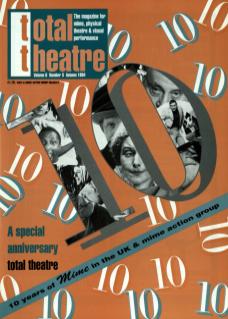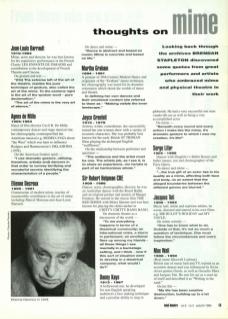Jean-Louis Barrault
1910-1994
Mime, actor and director, he was best known for his superlative performance in the French Classic Les Enfants du Paradis and contribution to the development of French Theatre and Cinema.
On gesture and text:
'[On] the extreme left of the art of the theatre, resides the pure technique of gesture, also called the art of the mime. To the extreme right is the art of the spoken word – pure declamation.'
‘The art of the mime is the very art of silence.’
Agnes de Mille
1905-1993
Niece of film director Cecil B. de Mille, contemporary dancer and stage musical star, her choreography contemporified the American musical, e.g. Rodeo (1942) about ‘the West’, which was later to influence Rodgers and Hammerstein's Oklahoma (1958).
On the American frontier spirit:
‘I use dramatic gesture, utilising, therefore, artist[s and] dancers in that order to convey terrifying and wonderful secrets identifying the characteristics of a people.’
Étienne Decroux
1895-1991
Grammarian of modern mime, teacher of innumerable contributors to the art of mime including Marcel Marceau and Jean-Louis Barrault.
On dance and mime:
‘Dance is abstract and based on music; Mime is concrete and based on life.’
Martha Graham
1894-1991
A pioneer of 20th Century Modern Dance and originator of the ‘Graham’ dance technique, her choreography was noted for its dramatic orientation which shook the worlds of dance and theatre.
In defining her own dances and their emotional content she referred to them as: ‘Making visible the inner landscape.’
Joyce Grenfell
1910-1979
Actress, writer, comedienne, she successfully toured her one-woman show with a variety of eccentric characters. She was probably best known for the early British St Trinian films playing the archetypal English ‘Wallflower’.
On the relationship between performer and spectator:
‘The audience and the artist must be one. The artists job, as I see it, is to share an experience... for he/she is part of an harmonious whole.’
Sir Robert Helpman CBE
1909-1986
Dancer, actor, choreographer, director, he was an Australian dancer with the Royal Ballet, and an original partner and mentor of Margot Fonteyn. He starred in the classic film The Red Shoes with Moira Shearer and was best known for playing the child catcher in Chitty Chitty Bang Bang.
On dramatic theatre as a microcosm of the world:
‘To me everything happens in terms of a theatrical community: an International crisis, a storm in parliament, an emotional flare up among my friends – all these things I see mentally in a backstage setting, and I think – now if this sort of situation were to develop in a theatrical company, what would I do?’
Danny Kaye
1913-1987
A Hollywood star, he developed for non-English speaking audiences a face making technique and a peculiar ability to sing in gibberish. He had a very successful one-man vaudeville act as well as being a very accomplished actor.
On mime:
‘Beneath every sound and every action I make lies the mime, it's dramatic gesture to which I owe my creation, it's life!’
Serge Lifar
1905-1986
Dancer with Diaghilev's Ballet Russes and ballet master, star and choreographer of the Paris Opera.
On dance and mime:
‘...the true gift of an actor lies in his quality as a mime, affecting both face and body... to an extent that the alleged boundaries between the different genres are blurred.’
Jacques Tati
1908-1982
Music hall star, mime and supreme athlete, he wrote, directed and starred in his own films, e.g. Mr Hulot’s Holiday and My Uncle.
On mime comedy:
‘One has to know what to do. Outside of that, it's not so much a question of technique. One must follow the circumstances and one's inspiration.’
Max Wall (real name Maxwell Lorimar)
1908-1990
British star of music hall and TV, trained as an eccentric dancer and was influenced by Swiss clown genius Grock, as well as Groucho Marx and Jacques Tati. He saw his act as a send up of itself and described it as ‘Writing in the sand’.
On his life:
‘My life has been creative destruction, building up to a let down.’

